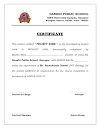BIOLOGY (Code No. 044)
COURSE STRUCTURE
CLASS XII (2021-22) (THEORY)
Unit-VI Reproduction
Chapter-1: Reproduction in Organisms
Reproduction, a characteristic feature of all organisms for continuation of species; modes of reproduction - asexual and sexual reproduction; asexual reproduction - binary fission, sporulation, budding, gemmule formation, fragmentation; vegetative propagation in plants; events in sexual reproduction.
Chapter-2: Sexual Reproduction in Flowering Plants
Flower structure; development of male and female gametophytes; pollination - types, agencies and examples; outbreeding devices; pollen-pistil interaction; double fertilization; post fertilization events - development of endosperm and embryo, development of seed and formation of fruit; special modes- apomixis, parthenocarpy, polyembryony; Significance of seed dispersal and fruit formation.
Chapter-3: Human Reproduction
Male and female reproductive systems; microscopic anatomy of testis and ovary; gametogenesis - spermatogenesis and oogenesis; menstrual cycle; fertilisation, embryo development upto blastocyst formation, implantation; pregnancy and placenta formation (elementary idea); parturition (elementary idea); lactation (elementary idea).
Chapter-4: Reproductive Health
Need for reproductive health and prevention of Sexually Transmitted Diseases (STDs); birth control - need and methods; medical termination of pregnancy (MTP); amniocentesis; infertility and assisted reproductive technologies - IVF, ZIFT, GIFT, AI (brief overview).
Unit-VII Genetics and Evolution
Chapter-5: Principles of Inheritance and Variation
Heredity and variation, Mendelian inheritance; deviations from Mendelism – incomplete dominance, co-dominance, multiple alleles and inheritance of blood groups, pleiotropy; elementary idea of polygenic inheritance; chromosome theory of inheritance; chromosomes and genes; linkage and crossing over; Sex determination - in human being, birds, grasshopper and honey bee; Mutation, Pedigree analysis, sex linked inheritance - haemophilia, colour blindness;
Mendelian disorders in humans –sickle cell anaemia, Phenylketonuria, thalassemia; chromosomal disorders in humans; Down's syndrome, Turner's and Klinefelter's syndromes.
Chapter-6: Molecular Basis of Inheritance
Structure of DNA and RNA; DNA packaging; Search for genetic material and DNA as genetic material; DNA replication; Central Dogma; transcription, genetic code, translation; gene expression and regulation - lac operon; Human genome project; DNA fingerprinting.
Chapter-7: Evolution
Origin of life; biological evolution and evidences for biological evolution (paleontology, comparative anatomy, embryology and molecular evidences); adaptive radiation; Biological evolution: Lamarck’s theory of use and disuse of organs, Darwin's theory of evolution; mechanism of evolution - variation (mutation and recombination) and natural selection with examples, types of natural selection; Gene flow and genetic drift; Hardy - Weinberg's principle; brief account of evolution; human evolution.
Unit-VIII Biology and Human Welfare
Chapter-8: Human Health and Diseases
Pathogens; parasites causing human diseases (malaria, dengue, chikungunya, filariasis, ascariasis, typhoid, pneumonia, common cold, amoebiasis, ring worm) and their control; Basic concepts of immunology - vaccines; cancer, HIV and AIDS; Adolescence - drug and alcohol abuse.
Chapter-9: Strategies for Enhancement in Food Production
Animal husbandry, Plant breeding, tissue culture, single cell protein.
Chapter-10: Microbes in Human Welfare
Microbes in food processing, industrial production, Antibiotics; production and judicious use, sewage treatment, energy generation and microbes as bio-control agents and bio-fertilizers.
Unit-IX Biotechnology and its Applications
Chapter-11: Biotechnology - Principles and Processes
Genetic Engineering (Recombinant DNA Technology).
Chapter-12: Biotechnology and its Application
Application of biotechnology in health and agriculture: genetically modified organisms - Bt crops; RNA interference, Human insulin, gene therapy; molecular diagnosis; transgenic animals; biosafety issues, biopiracy and patents.
Unit-X Ecology and Environment
Chapter-13: Organisms and Populations
Organisms and environment: Habitat and niche, abiotic factors, ecological adaptations; population interactions - mutualism, competition, predation, parasitism, commensalism; population attributes - growth, birth rate and death rate, age distribution.
Chapter-14: Ecosystem
Ecosystem: structure and function; productivity and decomposition; energy flow; pyramids of number, biomass, energy; nutrient cycles (carbon and phosphorous); ecological succession; ecological services - carbon fixation, pollination, seed dispersal, oxygen release (in brief).
Chapter-15: Biodiversity and Conservation
Biodiversity - Concept, levels, patterns, importance; loss of biodiversity; biodiversity conservation; hotspots, endangered organisms, extinction, Red Data Book, Sacred Groves, biosphere reserves, national parks, wildlife, sanctuaries and Ramsar sites.
Chapter-16: Environmental Issues
Air pollution and its control; water pollution and its control; agrochemicals and their effects; solid waste management; radioactive waste management; greenhouse effect and climate change impact and mitigation; ozone layer depletion; deforestation; case study exemplifying success story addressing environmental issue(s).







0 Comments